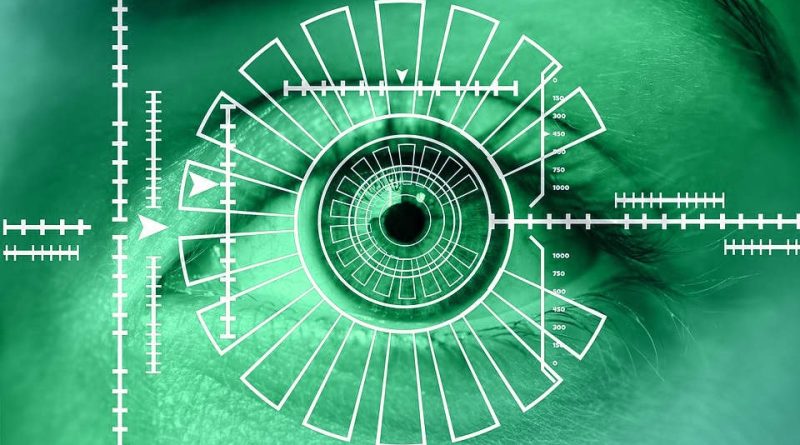Iris recognition systems in Contactless Biometric
A contactless biometric Technologies can either come in the form of a passive (biometric device continuously monitors Iris recognition systems in Contactless Biometric Technologies for the correct activation frequency) or active (user initiates activation at will) biometric . In either event, authentication of the user biometric should not take place until the user voluntarily agrees to present the biometric for sampling.
A contactless biometric can be used to verify a persons identity and offers at least two dimension that contact biometric technologies cannot match. A contactless biometric is one that does not require undesirable contact in order to extract the required data sample of the biological characteristic and in that respect a contactless biometric is most adaptable to people of variable ability levels.
Contactless Biometric Technologies are further divided in 4 different way of recognition but in all the case it mostly work is same way the contactless.
1. facial recognition
2. voice recognition
3. iris scan
4. retinal scan
Facial Recognition
Facial recognition records the spatial geometry of distinguishing features of the face. Different vendors use different methods of facial recognition, however, all focus on measures of key features. Facial recognition templates are typically 83 to 1,000 bytes. Facial recognition technologies can encounter performance problems stemming from such factors as no cooperative behavior of the user, lighting, and other environmental variables. Facial recognition has been used in projects to identify card counters in casinos, shoplifters in stores, criminals in targeted urban areas, and terrorists overseas.
Voice Recognition
Voice or speaker recognition uses vocal characteristics to identify individuals using a pass-phrase. Voice recognition can be affected by such environmental factors as background noise. Additionally it is unclear whether the technologies actually recognize the voice or just the pronunciation of the pass-phrase (password) used. This technology has been the focus of considerable efforts on the part of the telecommunications industry and NSA, which continue to work on improving reliability. A telephone or microphone can serve as a sensor, which makes it a relatively cheap and easily deploy able technology.
Iris recognition systems
Iris scanning measures the iris pattern in the colored part of the eye, although the iris color has nothing to do with the biometric. Iris patterns are formed randomly. As a result, the iris patterns in your left and right eyes are different, and so are the iris patterns of identical-cal twins. Iris scan templates are typically around 256 bytes. Iris scanning can be used quickly for both identification and verification Applications because of its large number of degrees of freedom. Current pilot programs and applications include ATMs , grocery stores (for checking out), and the few International Airports (physical access). If you like to check the biometric application then must view that post various applications of biometric.
Retinal Scan
Retinal scans measure the blood vessel patterns in the back of the eye. Retinal scan templates are typically 40 to 96 bytes. Because users perceive the technology to be somewhat intrusive, retinal scanning has not gained popularity with end-users. The device involves a light source shined into the eye of a user who must be standing very still within inches of the device. Because the retina can change with certain medical conditions, such as pregnancy, high blood pressure, and AIDS, this biometric might have the potential to reveal more information than just an individual’s identity.
Emerging biometric technologies:
Many inventors, companies, and universities continue to search the frontier for the next biometric that shows potential of becoming the best. Emerging biometric is a biometric that is in the infancy stages of proven technological maturation. Once proven, an emerging biometric will evolve in to that of an established biometric. Such types of emerging technologies are the following:
Brainwave Biometric
DNA Identification
Vascular Pattern Recognition
Body Odor Recognition
Fingernail Bed Recognition
Gait Recognition
Handgrip Recognition
Ear Pattern Recognition
Body Salinity Identification
Infrared Fingertip Imaging & Pattern Recognition
SECURITY ISSUES:
The most common standardized encryption method used to secure a company’s infrastructure is the Public Key Infrastructure (PKI) approach. That approach consists of two keys with a binary string ranging in size from 1024-bits to 2048-bits, the first key is a public key (widely known) and the second key is a private key (only known by the owner). However, the PKI must also be stored and inherently it too can fall prey to the same authentication limitation of a password, PIN, or token.
It too can be guessed, lost, stolen, shared, hacked, or circumvented; this is even further justification for a biometric authentication system. Because of the structure of the technology industry, making biometric security a feature of embedded systems, such as cellular phones, may be simpler than adding similar features to PCs. Unlike the personal computer, the cell phone is a fixed-purpose device. As an importance to successfully incorporate Biometrics, cell-phone developers need not gather support from nearly as many groups as PC-application developers must.
Security has always been a major concern for company executives and information technology professionals of all entities. Biometric authentication system that is correctly implemented can provide unparalleled security, enhanced convenience, heightened accountability, superior fraud detection, and is extremely effective in discouraging fraud. Controlling access to logical and physical assets of a company is not the only concern that must be addressed.
Companies, executives, and security managers must also take into account security of the biometric data (template). There are many urban biometric legends about cutting off someone finger or removing a body part for the purpose of gain access. This is not true for once the blood supply of a body part is taken away, the unique details of that body part starts to deteriorate within minutes. Hence the unique details of the severed body part(s) is no longer in any condition to function as an acceptable input for scanners. Best overall way to secure an enterprise infrastructure, whether it be small or large is to use a smart card. A smart card is a portable device with an embedded central processing unit (CPU).
The smart card can either be fashioned to resemble a credit card, identification card, radio frequency identification (RFID), or a Personal Computer Memory Card International Association (PCMCIA) card. The smart card can be used to store data of all types, but it is commonly used to store encrypted data, human resources data, medical data, financial data, and biometric data (template). Smart card can be access via a card reader, PCMCIA slot, or proximity reader. In most biometric-security applications, the system itself determines the identity of the person who presents himself to the system. Usually, the identity is supplied to the system, often by presenting a machine-readable ID card, and then the system asked to confirm. That problem is “one-to- one matching.” Today’s PCs can conduct a one-to-one match in, at most, a few seconds. One-to-one matching differs significantly from one-to-many matching. In a system that stores a million sets of prints, a one-to-many match requires comparing the presented fingerprint with 10 million prints (1 million sets times 10 prints/set).
A smart card is a must when implementing a biometric authentication system; only by the using a smart card can an organization satisfy all security and legal requirements. Smart cards possess the basic elements of a computer (interface, processor, and storage), and are therefore very capable of performing authentication functions right on the card. The function of performing authentication within the confines of the card is known as Matching on the Card (MOC) .
From a security prospective MOC is ideal as the biometric template, biometric sampling and associated algorithms never leave the card and as such cannot be intercepted or spoofed by others (Smart Card Alliance). The problem with smart cards is the public-key infrastructure certificates built into card does not solve the problem of someone stealing the card or creating one. A TTP (Trusted Third Party) can be used to verify the authenticity of a card via an encrypted MAC (Media Access Control).
CULTURAL BARRIERS or PERCEPTIONS:
People as diverse as those of variable abilities are subject to many barriers, theories, concepts, and practices that stem from the relative culture (i.e. stigma, dignity or heritage) and perceptions (i.e. religion or philosophical) of the international community. These factors are so great that they could encompass a study of their own. To that end, it is also theorized that to a certain degree that the application of diversity factors from current theories, concepts, and practices may be capable of providing a sturdy framework to the management of employees with disabilities.
Moreover, it has been implied that the term diversity is a synonymous reflection of the initiatives and objectives of affirmative action policies. The concept of diversity in the workplace actually refers to the differences embodied by the workforce members at large. The differences between all employees in the workforce can be equated to those employees of different or diverse ethnic origin, racial descent, gender, sexual orientation, chronological maturity, and ability; in effect minorities.






